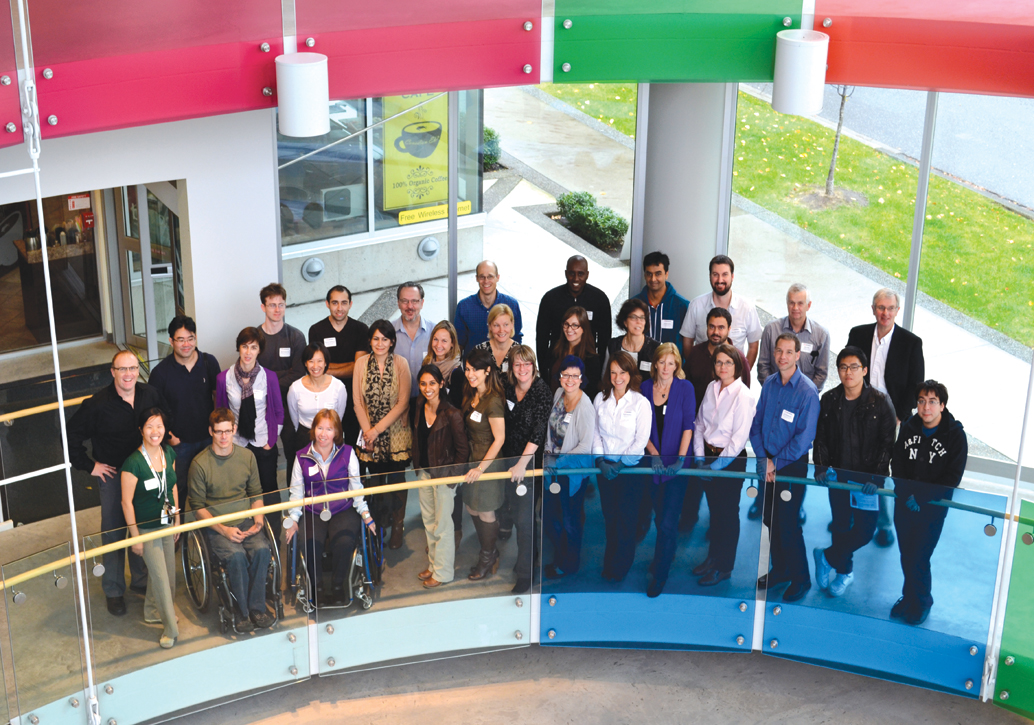Improving the wheeled mobility of older adults
By Dr. William Miller
Mobility impairment is one of the most common challenges faced by Canadians of 60 years and older, and as the baby boom population ages, the number of older Canadians living with mobility impairments will exponentially increase. Wheelchairs have therefore become important devices for mobility-impaired elderly people living independently or in long-term care facilities. In North America, the majority of long-term care residents over 65 years of age use wheelchairs to move about, representing around 800,000 individuals. In Canada, wheelchairs are used by five per cent of community-dwelling older adults and 50 per cent of those living in institutions. Importantly, more than half of these individuals require some form of help when using their wheelchair.
Power wheelchairs (PWCs) are a form of assistive technology that can compensate for impaired mobility and have a profound positive impact on the quality of life of older adults. These effects encompass improved well-being and self-esteem, reduced pain and discomfort, and enhanced activity, as well as participation and independence for individuals with limited or no walking ability. In fact, wheelchair provision is one of the top three rehabilitation interventions in terms of increasing function and quality of life for people with severe disabilities (the other two being eliminating accessibility barriers and providing skilled caregiver support).
Despite their numerous potential benefits, PWCs also have some notable drawbacks in terms of functionality, safety and cost-effectiveness. First, it can be challenging for older adults in particular to learn to use PWCs safely and effectively. Many PWC users struggle with operational difficulties, such as navigating indoor spaces and transporting their PWC in a vehicle. These problems are often exacerbated by insufficient training. Second, cognitive impairments or decreased mental or physical ability can restrict the usefulness of PWCs for some users. These challenges can lead to increased safety risks, such as tipping or falling during transfers. Finally, PWCs are very expensive—prices range from $6,100 to $28,000 per chair, and the added costs of cushions, switches, set-up, maintenance and eventual replacement must also be considered.
Given these issues around safety, functionality and cost-effectiveness, it is not surprising that wheelchairs are among the most frequently abandoned devices. Thus, if we hope to reduce wheelchair abandonment issues and help users gain the most from their devices, it is very important that we understand how PWCs can better meet users’ needs and skill levels. These were the reasons behind the formation of the CanWheel research team.
Our team
The CanWheel team comprises 14 clinical researchers and scientists across Canada with expertise in assistive technology, mobility and impairment, led by myself. In 2009, the team was awarded a Canadian Institute of Health Research Emerging Team Grant. The CanWheel team consists of computer scientists, engineers, epidemiologists, gerontologists, occupational therapists, physicians and sociologists, who share a common mission of improving the wheeled mobility of adults. In addition, more than 20 postgraduate, graduate and undergraduate trainees and 15 research assistants have actively contributed their talent to the research activities.
 The CanWheel team is committed to providing an integrated approach to enhancing the health, functioning and quality of life of older adult PWC users, and to help promote usage among populations that are normally unable to use PWCs.
The CanWheel team is committed to providing an integrated approach to enhancing the health, functioning and quality of life of older adult PWC users, and to help promote usage among populations that are normally unable to use PWCs.
Our guiding questions
The overall purpose of CanWheel is to improve the mobility of older adults who use PWCs by addressing three basic questions:
1. How are PWCs used now?
2. How can PWCs be used better?
3. How can PWCs be better?
How are power wheelchairs used now?
To address our first question, how PWCs are being used now, we are conducting a two-year longitudinal study among various groups of wheelchair users across Canada. These groups include both new and experienced users, as well as caregivers.
Participants in this study complete an assortment of questionnaires, and wheelchair users also perform the Wheelchair Skills Test (a questionnaire that assesses performance and safety on 32 wheelchair skills tasks). More than 127 PWC users and 35 caregivers have been enrolled in this study, and data collection will be completed in September 2014. This study has already generated useful data about PWC user confidence, participation and usage, as well as valuable information about caregiver burden (psychological vs. physical).
How can power wheelchairs be used better?
To address our second question, how PWCs can be used better, we are conducting a study examining the gaps in understanding of wheelchair skills training; particularly, the safety and efficacy of such training for PWC users. While some earlier work has looked at implementing a training program for manual wheelchair users, only a few small studies have looked at similar training for PWC users.
Our study has been designed to look at the impact of a PWC skills training program, focusing on health, function and social participation. In this study, participants assigned to the intervention group are set SMART (specific, measurable, attainable, relevant and time-bound) goals with a trainer, with skills practiced during five training sessions over the course of one month. During testing sessions, participants are asked to complete questionnaires assessing their wheelchair usage, confidence and skills. Currently, nearly 100 PWC users across Canada are participating in this study. The current program of research will generate a wheeled mobility outcome measures toolkit for older adults, which could benefit wheelchair skills training programs.
How can power wheelchairs be better?
To address our third question, how PWCs can be better, we have examined the perceived effectiveness, impact and relevance of wheeled mobility devices for users, caregivers, health care providers, policy makers and funding agencies through a series of focus groups, qualitative interviews and observational trials. Our initial findings support the use of collision avoidance for PWC users, particularly since our participants have raised concerns regarding driving safety and the risk of injury to others. We have also identified important technology design issues, such as the need for improved reliability. The importance of the PWC user maintaining as much autonomy as possible was also expressed by many of our participants. Our results support the need for a collaboratively controlled intelligent PWC. We are currently piloting a prototype “intelligent wheelchair” that prevents the user from driving into obstacles.
To further address our third question—and with the recognition that information on wheelchair behaviour itself can provide critical information on how to improve this mobility device—the CanWheel team is completing a scoping review on the types of data-loggers that are currently being used with PWCs. A data-logger is a collection of sensors that store information about wheelchair behaviour (e.g., how far or fast a wheelchair travels). This review will inform a planned survey of consumers, researchers and clinicians to discover the outcomes of greatest relevance, importance and impact for PWC users when implementing data-logger technology, and inform the design of an intelligent PWC.
The future
Our collective vision is to design a PWC that is better suited to meet the needs of elderly users. The proposed wheelchair will be capable of operating in both indoor and outdoor settings, and will include vocal prompting features to assist users with memory challenges (e.g., “It is time for lunch. If you would like to go to the dining room, please drive through the door on the left”). Recognizing that the aging population has diverse and dynamic needs, the team intends to make common hardware and software designs publically available, which will allow wheelchairs to be easily customized for individual users and adapted as the user ages.
The CanWheel team has already published numerous papers and given more than 50 national and international presentations and workshops on different aspects of these projects and the team. We will continue building on existing research developments in the area of wheeled mobility for the aging population, while taking our findings in new and exciting directions. We hope that interventional research will significantly benefit wheelchair skills training programs and smart wheelchair technology, and that the measurement research will generate a wheeled mobility measurement toolkit for older adults. We expect CanWheel to engender valuable contributions to the field of wheeled mobility research, including a clearer picture of how PWCs are currently used, how these devices can be enhanced and how an aging population can use them more effectively.
For more information, please visit www.canwheel.ca.
Dr. William C. Miller, PhD, FCAOT, is a professor in the Department of Occupational Science and Occupational Therapy at the University of British Columbia, and Co-Director of the VCHRI Rehabilitation Research Program at the GF Strong Rehabilitation Centre.














